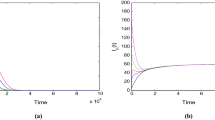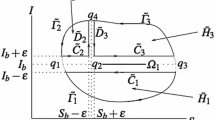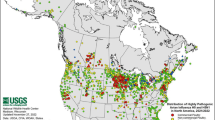Abstract
The widespread impact of avian influenza viruses not only poses risks to birds, but also to humans. The viruses spread from birds to humans and from human to human In addition, mutation in the primary strain will increase the infectiousness of avian influenza. We developed a mathematical model of avian influenza for both bird and human populations. The effect of half-saturated incidence on transmission dynamics of the disease is investigated. The half-saturation constants determine the levels at which birds and humans contract avian influenza. To prevent the spread of avian influenza, the associated half-saturation constants must be increased, especially the half-saturation constant H m for humans with mutant strain. The quantity H m plays an essential role in determining the basic reproduction number of this model. Furthermore, by decreasing the rate β m at which human-to-human mutant influenza is contracted, an outbreak can be controlled more effectively. To combat the outbreak, we propose both pharmaceutical (vaccination) and non-pharmaceutical (personal protection and isolation) control methods to reduce the transmission of avian influenza. Vaccination and personal protection will decrease β m, while isolation will increase H m. Numerical simulations demonstrate that all proposed control strategies will lead to disease eradication; however, if we only employ vaccination, it will require slightly longer to eradicate the disease than only applying non-pharmaceutical or a combination of pharmaceutical and non-pharmaceutical control methods. In conclusion, it is important to adopt a combination of control methods to fight an avian influenza outbreak.













Similar content being viewed by others
References
Alexander ME, Bowman C, Moghadas SM, Summers R, Gumel AB, Sahai BM (2004) A vaccination model for transmission dynamics of influenza. SIAM J Appl Dyn Syst 3:503–524
Alexander ME, Moghadas SM, Wu J (2008) A delay differential model for pandemic influenza with antiviral treatment. Bull Math Biol 70:382–397
Bowman C, Gumel AB, van den Driessche P, Wu J, Zhu H (2005) A mathematical model for assessing control strategies against West Nile virus. Bull Math Biol 67:1107–1133
Capasso V, Serio G (1978) A generalization of the Kermack–McKendrick deterministic epidemic model. Math Biosci 42:43–61
Centers for Disease Control and Prevention (2007) CDC avian influenza: current H5N1 situation. http://www.cdc.gov/flu/avian/outbreaks/current.htm (Accessed 28 Jan 2013)
Centers for Disease Control and Prevention (2010) Key facts about avian influenza (bird flu) and highly pathogenic avian influenza A (H5N1) virus. http://www.cdc.gov/flu/avian/gen-info/facts.htm (Accessed 28 Jan 2013)
Centers for Disease Control and Prevention (2012) Human infection with avian influenza A (H5N1) virus: advice for travelers. http://wwwnc.cdc.gov/travel/page/human-infection-avian-flu-h5n1-advice-for-travelers-current-situation.htm (Accessed 28 Jan 2013)
Chan YJ, Lee CL, Hwang SJ et al (2010) Seroprevalence of antibodies to pandemic (H1N1) 2009 influenza virus among hospital staff in a medical center in Taiwan. J Chin Med Assoc 73:62–66
Chowell G, Ammon CE, Hengartner NW, Hyman JM (2005) Transmission dynamics of the great influenza pandemic of 1918 in Geneva, Switzerland: assessing the effects of hypothetical interventions. J Theor Biol 241:193–204
Doyle A, Bonmarin I, Lévy-Bruhl D, Le Strat Y, Desenclos J (2006) Influenza pandemic preparedness in France: modelling the impact of interventions. J Epidemiol Commun Health 60:399–404
Du Y, Xu R (2010) A delayed SIR epidemic model with nonlinear incidence rate and pulse vaccination. J Appl Math Inform 28:1089–1099
Fisher D, Hui D, Zhancheng G, Lee C et al (2011) Pandemic Response Lessons from Influenza H1N1 2009 in Asia Respirol 16:876–882
Food and Agriculture Organization of the United Nations (2004) FAO recommendations on the prevention, control and eradication of highly pathogenic avian influenza (HPAI) in Asia (proposed with the support of the OIE). http://www.fao.org/ag/againfo/programmes/en/programmes.htm (Accessed 30 Jan 2013)
Food and Agriculture Organization of the United Nations (2008) Possible modes of transmission of avian viruses to people: studies in experimental models. http://www.fao.org/docs/eims/upload//250678/aj155e00.pdf (Accessed 30 Jan 2013)
Gao S, Chen L, Nieto JJ, Torres A (2006) Analysis of a delayed epidemic model with pulse vaccination and saturation incidence. Vaccine 24:6037–6045
Government of Ontario (2006) Avian influenza: a guide to personal protective clothing and equipment for workers and employers working with or around poultry or wild birds. http://www.health.gov.on.ca/en/pro/programs/emb/avian/docs/avian_ppe_guide.pdf (Accessed 30 Jan 2013)
Gumel AB (2009) Global dynamics of a two-strain avian influenza model. Int J Comput Math 86:85–108
Hospital Influenza Working Group (2009) Management of novel influenza epidemics in Singapore: consensus recommendations from the hospital influenza (Singapore). Singapore Med J 50:567–580
Iwami S, Takeuchi Y, Liu X (2007) Avian–human influenza epidemic model. Math Biosci 207:1–25
Iwami S, Suzuki T, Takeuchi Y (2009) Paradox of vaccination: is vaccination really effective against avian flu epidemics? PLoS One 4:e4915
Kaddar A (2009) On the dynamics of a delayed SIR epidemic model with a modified saturated incidence rate. Electr J Differ Equ 133:1–7
Kaddar A (2010) Stability analysis in a delayed SIR epidemic model with a saturated incidence rate. Nonlinear Anal Model Control 15(3):299–306
Kilbourne ED (2006) Influenza pandemics of the 20th century. Emerg Infect Dis 12:9–14
Li J, Blakeley D, Smith? RJ (2011) The failure of R 0. Comput Math Methods Med 2011:527610
Lipsitch M, Cohen T, Murray M, Levin BR (2007) Antiviral resistance and the control of pandemic influenza. PLoS Med 4:e15
Liu X, Yang L (2012) Stability analysis of an SEIQV epidemic model with saturated incidence rate. Nonlinear Anal Real World Applic 13:2671–2679
Longini IM, Halloran ME, Nizam A, Yang Y (2004) Containing pandemic influenza with antiviral agents. Am J Epidemiol 159:623–633
Marangon S, Cecchinato M, Capua I (2008) Use of vaccination in avian influenza control and eradication. Zoonoses Public Health 55:65–72
May RM, Anderson RM (1978) Regulation and stability of host–parasite population interactions: II. Destabilizing processes. J Anim Ecol 47:249–267
Nuño M, Chowell G, Gumel AB (2006) Assessing the role of basic control measures, antivirals and vaccine in curtailing pandemic influenza: scenarios for the US, UK and the Netherlands. J R Soc Interface 4:505–521
Perko L (2001) Differential equations and dynamical systems, 3rd edn. Springer, New York
Ruan S, Wang W (2003) Dynamical bahavior of an epidemic model with a nonlinear incidence rate. J Differ Equ 188:135–163
Stuart-Harris C (1979) Epidemiology of influenza in man. Br Med Bull 35:3–8
Tchuenche JM, Dube N, Bhunu CP, Smith? RJ, Bauch CT (2011) The impact of media coverage on the transmission dynamics of human influenza. BMC Public Health 11(Suppl 1):S5
van den Driessche P, Watmough J (2002) Reproduction numbers and sub-threshold endemic equilibria for compartmental models of disease transmission. Math Biosci 180:29–48
Wei C, Chen L (2008) A delayed epidemic model with pulse vaccination. Discrete Dyn Nat Soc 2008:746951
World Health Organization (2006) Avian influenza, including influenza A (H5N1), in humans: WHO interim infection control guideline for health care facilities. https://www.premierinc.com/quality-safety/tools-services/safety/topics/influenza/downloads/07-who-ai-inf-control-guide05-10-07.pdf (Accessed 30 Jan 2013)
World Health Organization (2007) Options for the use of human H5N1 influenza vaccines and the WHO H5N1 vaccine stockpile. http://www.who.int/csr/resources/publications/WHO_HSE_EPR_GIP_2008_1d.pdf (Accessed 30 Jan 2013)
World Health Organization (2011) New: WHO comment on the importance of global monitoring of variant influenza viruses. http://www.who.int/influenza/human_animal_interface/avian_influenza/h5n1-2011_12_19/en/index.html (Accessed 30 Jan 2013)
World Health Organization (2012) H5N1 avian influenza: timeline of major events. http://www.who.int/influenza/human_animal_interface/avian_influenza/H5N1_avian_influenza_update.pdf (Accessed 30 Jan 2013)
Yang J, Zhang F, Wang X (2007) A class of SIR epidemic model with saturation incidence and age of infection. Ninth ACIS international conference on software engineering, artificial intelligence, networking, and parallel/distributed computing, vol 1, pp 146–149
Yang Y, Sugimoto JD, Halloran ME, Basta NE et al (2009) The transmissibility and control of pandemic influenza A (H1N1) virus. Sci Agric 326:729–733
Zhang F, Li Z-Z, Zhang F (2008) Global stability of an SIR epidemic model with constant infectious period. Appl Math Comput 199:285–291
Zhou Y, Liu H (2003) Stability of periodic solutions for an SIS model with pulse vaccination. Math Comput Model 38:299–308
Acknowledgments
NSC acknowledges support from the Ministry of Higher Education, Malaysia, and the Department of Mathematics, University of Malaysia Terengganu. For citation purposes, please note that the question mark in “Smith?” is part of his name.
Author information
Authors and Affiliations
Corresponding author
Appendices
Appendix 1: Feasibility of the solution
Since the model parameters are non-negative, it is important to show that all state variables remain non-negative for all non-negative initial conditions for t ≥ 0. From Eq. (2.1), we have
The closed set
is a feasible region of the model.
Proposition 1
The closed set \({\mathcal{D}}\) is bounded and positively invariant.
Proof
Because \(\frac{{\rm d}N_{\rm b}}{{\rm d}t}\leq \Uplambda_{\rm b}-\mu_{\rm b} N_{\rm b}, \, N_{\rm b}\) is bounded above by \(\frac{\Uplambda_{\rm b}}{\mu_{\rm b}}. \) Hence \(\frac{{\rm d}N_{\rm b}}{{\rm d}t}<0\) whenever \(N_{\rm b}(t)>\frac{\Uplambda_{\rm b}}{\mu_{\rm b}}.\) Using an integrating factor, we have
As \( t \rightarrow \infty,\; {\rm e}^{-\mu_{\rm b}t}\rightarrow 0\) and hence \(\lim_{t \to \infty}N_{\rm b}(t)\leq \frac{\Uplambda_{\rm b}}{\mu_{\rm b}}.\)
The other case is similar. Thus \({\mathcal{D}}\) is bounded and positively invariant in \(\mathbb{R}_+ ^5.\)
Appendix 2: Stability analysis of the avian-only model
We consider the avian-only model, given by the first two equations of the Eq. (2.1)
A feasible region is defined as
It can be shown from Proposition 1 that \({\mathcal{D}}_{\rm b}\) is bounded and positively invariant over \(\mathbb{R} _+^2. \) The DFE (disease-free equilibrium) is
and the EE (endemic equilibrium) is
The basic reproduction number (see Li et al. 2011; van den Driessche and Watmough 2002 for further details and some complications) for the avian-only model is thus
Next, we would like to determine whether or not the model achieves global stability of the DFE or EE with respect to positive initial conditions.
Theorem 2
(Global stability of the DFE for the avian-only model) Let \(E_{\rm b}^{0}=(S_{\rm b}^{0},I_{\rm b}^{0})=\left(\frac{\Uplambda_{\rm b}}{\mu_{\rm b}}, 0\right). \) If R b < 1, then the DFE, E 0b , is globally stable in the interior \(\Upgamma_{\rm b}=\{(S_{\rm b},I_{\rm b})\in \mathbb{R}^2_{+}: S_{\rm b}, I_{\rm b}\le N_{\rm b}\}. \)
Proof
Consider a Lyapunov function, \(L(S_{\rm b},I_{\rm b})=\frac{\Uplambda_{\rm b}}{\mu_{\rm b}H_{\rm b}(\mu_{\rm b}+\delta_{\rm b})}I_{\rm b}. \) At the DFE, we have \(L(S_{\rm b}^{0},I_{\rm b}^{0})=L\left(\frac{\Uplambda_{\rm b}}{\mu_{\rm b}}, 0\right)=0. \) Its derivative is
Thus a periodic solution for this avian-only model does not exist for \((S_{\rm b}, I_{\rm b}) \in \Upgamma_{\rm b}. \) Therefore, the global stability of the DFE is satisfied.□
Theorem 3
(Global stability of the EE for the avian-only model) Let \( E_{\rm b}^*=(S_{\rm b}^*,I_{\rm b}^*) \). If R b > 1, then the EE, E *b , is globally stable in \({\Upgamma_{\rm b} = \{(S_{\rm b},I_{\rm b})\in \mathbb{R}_{+}^{2}: S_{\rm b}\le N_{\rm b}, I_{\rm b}\le N_{\rm b}\}. }\)
Proof
Let \(f_{1}=\Uplambda_{\rm b}-\mu_{\rm b}S_{\rm b}-\frac{\beta_{\rm b} S_{\rm b} I_{\rm b}}{H_{\rm b}+I_{\rm b}},\,f_{2}=\frac{\beta_{\rm b} S_{\rm b}I_{\rm b}}{H_{\rm b}+I_{\rm b}}-(\mu_{\rm b}+\delta_{\rm b})I_{\rm b}\) and \(B(S_{\rm b},I_{\rm b})=\frac{1}{I_{\rm b}}.\)
As \(\nabla(Bf)<0 \forall\ (S_{\rm b}, I_{\rm b}) \in \Upgamma_{\rm b},\) then by Bendixson’s Negative Criterion (Perko 2001), no periodic orbit can lie entirely in \(\Upgamma_{\rm b}.\) Since R b > 1, the DFE is unstable and hence, in a two-dimensional system, the EE is globally stable in \(\Upgamma_{\rm b}. \)□
Appendix 3: Stability analysis of the avian–human model
Since R h decouples from the remaining equations in model (2.1), we consider the first five equations of model (2.1). We denote this as the avian–human model.
The transmission matrix, F, and transition matrix, V, of this model are
Thus we have
The DFE of this model is
At the DFE, we have
and
where \(R_{{\rm h}1}=\frac{\beta_{\rm a}\Uplambda_{\rm h}}{H_{\rm a}\mu_{\rm h}(\mu_{\rm h}+d+\epsilon+\gamma_{\rm a})} \quad \hbox {and} \; \quad R_{{\rm h}2}=\frac{\beta_{\rm m}\Uplambda_{\rm h}}{H_{\rm m}\mu_{\rm h}(\mu_{\rm h}+\alpha+\gamma_{\rm m})}. \)
Theorem 4
(Global stability of the DFE for the avian–human model) Let \(E_{\rm ah}^0=(S_{\rm b}^0, I_{\rm b}^0, S_{\rm h}^0, I_{\rm a}^0, I_{\rm m}^0)=\left (\frac{\Uplambda_{\rm b}}{\mu_{\rm b}}, 0, \frac{\Uplambda_{\rm h}}{\mu_{\rm h}}, 0, 0\right). \) If R ah < 1, then the DFE, E 0ah , is globally stable in the interior \({\Upgamma_{\rm ah}=\{(S_{\rm b},I_{\rm b},S_{\rm h},I_{\rm a},I_{\rm m})\in \mathbb{R}^5_{+}: S_{\rm b}, I_{\rm b}\le N_{\rm b}, S_{\rm h}, I_{\rm a}, I_{\rm m}\le N_{\rm h}\}. }\)
Proof
Consider a Lyapunov function,
At the DFE, we have \(L(S_{\rm b}^0,I_{\rm b}^0,S_{\rm h}^{0},I_{\rm a}^0,I_{\rm m}^0)=L\left(\frac{\Uplambda_{\rm b}}{\mu_{\rm b}},0,\frac{\Uplambda_{\rm h}}{\mu_{\rm h}}, 0, 0\right)=0. \) Its derivative is
Thus, a periodic solution for this avian–human model does not exist for \((S_{\rm b},I_{\rm b},S_{\rm h}, I_{\rm a}, I_{\rm m}) \in \Upgamma_{\rm ah}. \)□
Rights and permissions
About this article
Cite this article
Chong, N.S., Tchuenche, J.M. & Smith, R.J. A mathematical model of avian influenza with half-saturated incidence. Theory Biosci. 133, 23–38 (2014). https://doi.org/10.1007/s12064-013-0183-6
Received:
Accepted:
Published:
Issue Date:
DOI: https://doi.org/10.1007/s12064-013-0183-6




